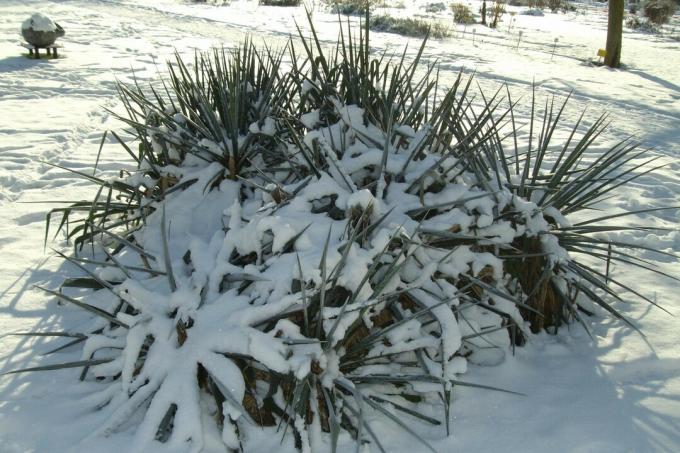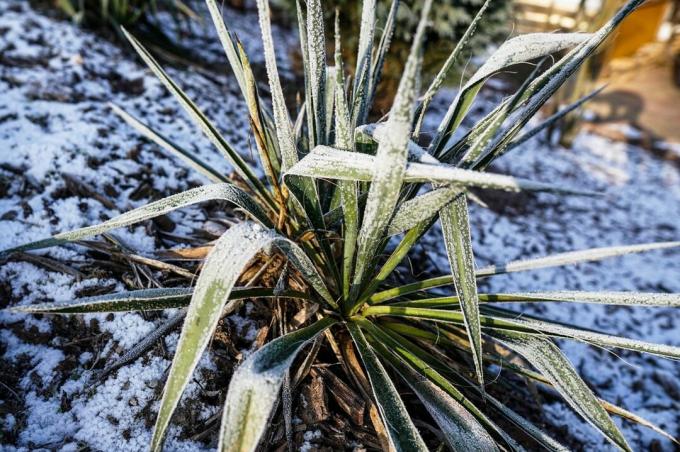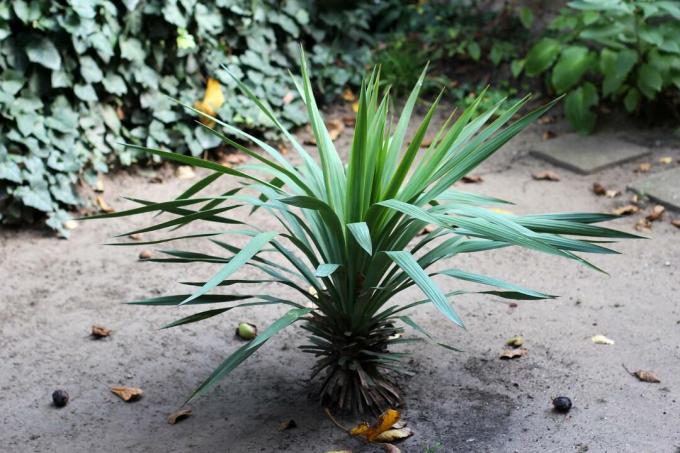The beautiful exotic woman needs special protection in winter. Everything you need to know about wintering yucca palms is explained in this article.

Yucca palms (yucca), often also called palm lilies, are extremely popular house plants with us. What is less well known, however, is that some types of yucca can also overwinter outdoors. But no matter whether in the house or in the garden - the right protection is important so that the palm trees can survive the winter well. Therefore, in this article you will find out whether the yucca palm is hardy, when it starts to get too cold and how you can properly overwinter the yucca indoors and outdoors.
contents
- Is the yucca palm hardy?
- When does the yucca palm get too cold?
-
Hibernate yucca palms indoors or outdoors?
- Hibernate the yucca palm outside in the bed
- Hibernate the yucca palm outside in a pot
- Hibernate yucca palm indoors
- Caring for the yucca palm after the winter
In this country, the yucca palm is a popular houseplant, which often ensures a good indoor climate in living rooms or in the office. No wonder, as the palm is considered easy to care for and robust and can reach impressive sizes of up to five meters in height. But the palm lily does not only cut a good figure as a houseplant. Yucca palms can also be grown outdoors - not just in pots, but even in the garden bed. But palm trees in our garden - is that even possible? That's fine! If a few tips and tricks for correct winter storage are taken into account, you too can enjoy the snow-covered palm trees in the winter garden.

Is the yucca palm hardy?
In order to understand whether the yucca palm is winter hardy or not, it is first necessary to take into account that there are around 50 different types of yucca worldwide. Of course, not all of these have the same claims and properties. The yucca originally comes from dry to desert-like areas of the American continent. So you could think that the palm tree prefers to be warm all year round. But that's only partially true. There are definitely hardy and frost-tolerant species among the yucca palms. A total of around ten types of yucca are considered winter hardy. We have briefly summarized for you which of these are particularly suitable for cultivation in our home gardens.
An overview of the hardy yucca palm species:
- Banana yucca (Yucca baccata): Winter hardiness down to -25 ° C
- Blue-green yucca (Yucca glauca): Frost tolerance down to -18 ° C
- Fädige-Yucca (Yucca filamentosa): The lowest temperature is -25 ° C
- Candle Yucca (Yucca gloriosa): Frost tolerance down to -20 ° C
- Short-leaf yucca (Yucca brevifolia): Frost tolerance down to -20 ° C
- Soap Tree Yucca (Yucca elata): Winter hardiness down to -20 ° C

Apart from these, the other yucca species are not hardy and must therefore be overwintered indoors. So that you can be sure which yucca palm you are dealing with, it is best to pay attention to the exact species and variety name of the plant when you buy it.
When does the yucca palm get too cold?
Even though most yucca palms are houseplants, they too will enjoy a summer outdoors. The fresh air and the higher light irradiation are good for the indoor plants. But if the temperatures drop below 20 ° C, it is time to bring the yucca palm inside. The situation is different, of course, with free-range yuccas. Depending on the species, they can withstand temperatures of down to -25 ° C and can therefore spend the whole winter outdoors.
Summary: When does the yucca palm get too cold?
- Room yucca: Temperatures below 20 ° C
- Yucca in the bed: -18 ° C to -25 ° C
- Yucca in a pot outdoors: -18 ° C to -25 ° C

Hibernate yucca palms indoors or outdoors?
So whether your yucca palm should be overwintered outside or inside depends on the species. In any case, varieties that are not hardy must be overwintered indoors. Hardy species in the bed can survive the winter with proper protection outdoors. In the case of actually hardy species in the pot, it depends on the age of the plant. If the plant is younger than three years, it is advisable to overwinter it. After three years, the plant will finally be large enough to survive the winter outdoors in pots.
How to go about wintering yucca palms outdoors, whether in beds or pots, and with indoor plants, you will now find out in detail in the next section.
Hibernate the yucca palm outside in the bed
In order to prepare the yucca palm in time for winter, stop fertilizing in autumn. The last fertilization should be done at the end of July, at the latest at the beginning of August.
The greatest challenge when overwintering palm trees in the garden is moisture. The yucca originally comes from desert areas and therefore finds it difficult to cope with the increased humidity in winter. That is why moisture protection is the most important thing. If the palm is still young, it may be advisable to equip it with a small canopy for the winter. It is important that the air can circulate adequately despite the roof. Alternatively, you can also tie the top of the palm together with some raffia. In this way, the sensitive palm heart is protected from moisture and frost. Young plants can also be secured by wrapping a fleece or a jute sack around the tuft of palm. Here again, good moisture protection is essential so that the moisture does not collect in the material. To protect the roots from frost, apply a layer of mulch at least 8 inches thick around the plant. Bark mulch, leaves or fir branches are suitable for this. So your palm will survive the winter unscathed. It is important that you remove the antifreeze quickly after the last frost, otherwise too much water can collect on the roots and in the palm tree.

An overview of the yucca palm in the bed:
- Last fertilization: July / August
- Install moisture protection
- Or tie a tuft of palm together
- If necessary, protect with fleece or a jute sack
- Spread the mulch layer
- Winterize early after the last frost
Tip: If your yucca palm has suffered frost damage despite all protective measures, all is not lost. As long as the roots have not been damaged, the yucca will sprout again.
Hibernate the yucca palm outside in a pot
Even with yucca palms in pots, the most important thing is to protect them from too much moisture. The advantage of potted plants is their mobility. In autumn, therefore, place your yucca in the bucket in a sheltered place such as a house wall, where it is partly protected from rain. The second step is then to install moisture protection from below. This can be a wooden plate or a plexiglass pane on which the pot is placed. Now the bucket is insulated by wrapping it several times with insulation material such as jute sacks, coconut fibers or bubble wrap. This will prevent the roots from freezing in the tub. Finally, cover the substrate in the bucket with a layer of mulch at least 20 centimeters thick.
If winter is over and no more frost is to be expected, it is also important to remove the frost protection from the potted plant in good time.

Hibernate the yucca palm outside in a pot - in a nutshell:
- Move to a sheltered place in autumn
- Provide moisture protection from below
- Isolate the bucket
- Cover the substrate with a layer of mulch
- Winterize early after the last frost
Hibernate yucca palm indoors
Palm lilies in the room should first be prepared for winter by stopping fertilization. The last fertilizer application therefore takes place in October. From November the plant can move to its winter quarters. The yucca palm could also overwinter in a warm living room, but a cooler place is better, because the palm feels most comfortable in winter at temperatures between 5 and 10 ° C. Another important factor is light. The winter quarters should be as bright as possible, but also not exposed to the blazing sun. Yellowed lower leaves indicate a lack of light.

A humidity of 50 to 60 percent is ideal for wintering. If the air is dry, you can spray your yucca occasionally (not too often) with water. The watering is less in winter. You should definitely avoid too much moisture, otherwise the roots could rot. Therefore, it is better to check the substrate with your finger before watering and determine the moisture. Yellow leaves that turn brown later can be an indication of either too much or too little moisture.
You shouldn't fertilize at all in winter. The room in which the plant is located should be ventilated every now and then. It is also crucial to regularly check the palm for pests. Yucca is particularly susceptible to this when the conditions for wintering are not ideal. Spider mites (Tetranychidae) and Scale insects (Coccoidea) then often plague yucca palms. Regular checks are therefore essential in order to be able to react in good time and to combat the pests.
If the winter has survived well, the plant can move back to its usual place in the apartment or office in spring. At temperatures above 20 ° C, it can also be put outside again.
Step-by-step instructions: Hibernate the yucca palm indoors:
- Last fertilization in October
- Place in a bright and cool room from November
- Ideal temperature: 5 - 10 ° C
- Humidity 50 - 60%
- Alternatively, spray now and then
- Pour moderately
- Do not fertilize
- Ventilate every now and then
- Regular pest control
Caring for the yucca palm after the winter
If your yucca palm has survived the cold season well, it will receive more light and warmth in spring so that it can grow undisturbed. Everything about the right one Care of yucca palms can be read here.

You can remove frozen and dried-out parts of the plant in the spring. Spring is also a good time to repot the palm if necessary. In the spring it is time to increase the watering again, but you should still not overdo it and keep in mind that the palm lily is a desert plant. From spring onwards, the yucca will be supplied with nutrients again every three weeks. An organic liquid fertilizer is ideally suited for this. Our Plantura citrus & Mediterranean liquid fertilizer releases its nutrients gently and is therefore the best choice for your yucca palm.
Summary: How To Care For Yucca Palm After Winter?
- Remove frozen or dried out parts of the plant
- Possibly repot
- Pour more again
- Start fertilizing again
If you would like to learn more about the wintering of palm trees, you will find everything about the in our article here Wintering of palm trees in general or via the Wintering of hemp palms.

